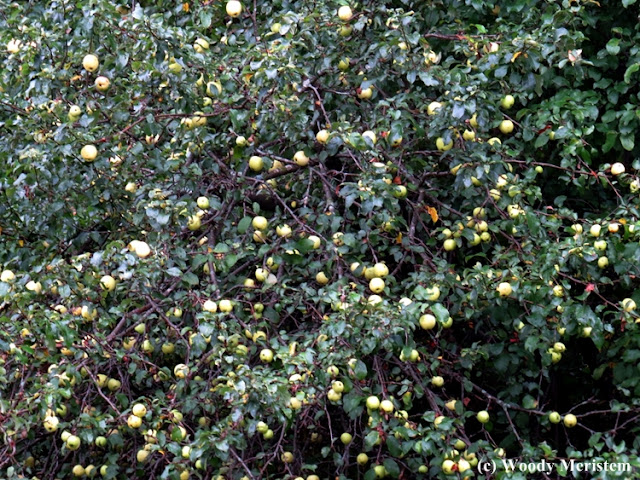Well, here it is
the middle of autumn and the trees and shrubs of forest and field are in the
midst of one of the most fruitful autumns in many years. Oaks, both red and
white, are dropping acorns. Although the oaks had a larger crop of acorns last
year, in some areas walking in the woods is like walking on ball bearings as the
acorns littering the ground roll underfoot.
The chipmunks,
blue jays and squirrels are busy squirreling away their winter food supply –
Even the beech
trees have produced one of their infrequent crops of seed –
Grapevines are
sagging under the weight of their abundant crop that will feed ruffed grouse,
fox, songbirds and wild turkeys –
Everywhere we go
the apple trees, both cultivated and wild are laden with fruit, fruit that in
some cases is heavy enough to break the trees’ limbs.
There are apples
of every size and color, some pretty enough to grace the shelf of a grocery
store -
Some misshapen, discolored and covered with blemishes -
The appearance of
the apples doesn’t matter to the wildlife that feeds heavily on apples. The
raccoons munch away –
Gray fox may be
carnivores, but they eat apples too –
As soon as the
apples started to fall the white-tailed deer began cleaning up the fruit that
fell from the trees –
One of my camera
traps captured a sequence of a young buck devouring two apples –
Over broad areas,
trees of the same species typically produce bumper crops of seed at the same
time, often on a three to seven year cycle. The question that is often asked is
how trees coordinate their seed production over
wide portions of their range. It seems that temperature and available moisture
are major factors coupled with the fact that heavy seed production severely
depletes a tree’s reserves such that several years are required for those
reserves to be rebuilt sufficiently to allow significant seed production again.
This cyclic seed
production also serves another purpose – if seed or fruit production was consistent from year to year, seed
predators (weevils, moths, mice, chipmunks, squirrels, turkeys, deer, bear)
could build populations large enough to consume all the seed every year. With cycles of scarcity and abundance, there may not be enough seed predators to consume all the seed
produced in good years. And so, some seed survives to germinate and grow.










I love how you've shared a multitude of autumn in your words and beautiful images. It certainly looks like autumn is in full force where you live.
ReplyDeleteSharing snapshots at Captured By Jade
Sure don't see those Beech seeds very much, though we've got all the rest. I remember my parents going out to gather beech nuts and keeping a jar full for the winter.
ReplyDeleteHello, the fruits and nuts seem plentiful this year. I am sure the critters will have a feast. Cool shot of the raccoon, fox and deer. Thank you for linking up and sharing your post. Have a happy weekend!
ReplyDeleteWonderful photos of the abundance and happy creatures enjoying it! Interesting information about the seed cycles, too. - Karen
ReplyDeleteOur squirrel, chipmunk and woodrat (packrat) have been very busy gathering food to store away. The squirrel and chipmunk are polite about it, but the woodrat is a glutton and cuts down all my tender plants in the garden. - Margy
ReplyDelete